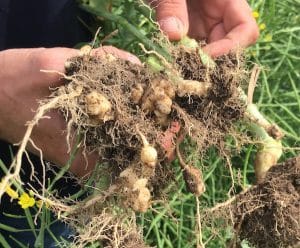Nine new strains of clubroot have been discovered in Western Canadian fields, meaning genetic resistance to the canola killer disease isn’t enough, researchers at the University of Alberta (U of A) say in a news release on March 16.
“We can’t just rely on genetic resistance. There’s no silver bullet control — it’s more about multiple strategies,” lead researcher Keisha Hollman says in the release.
The new pathogens were discovered in canola fields tested across Alberta, Saskatchewan and Manitoba in 2017 and 2018, meaning the resistance breakdown first discovered in 2013 is growing.
The research was published in the Canadian Journal of Plant Pathology and brings the number of known clubroot pathotypes to 36 — 19 or which can overcome the “first-generation” resistance to clubroot found in most canola varieties grown in Canada.
Multiple strains of clubroot can occur in a field at any given time and can overtake the pathotype that canola was originally bred to resist, the release notes.
“We’re growing the same resistance source over and over again, and that’s giving these other strains living in the soil the opportunity to grow their population,” Hollman explains. “That means there’s a new dominant pathotype in the field, which first-generation resistance can’t control.”
Clubroot is caused by a parasite which infects field soil with resting spores that can survive up to 20 years, the release says. Canola and related plants such as cabbage which are grown in the infected soil develop tumours on the roots, which block water and nutrient uptake, causing stunted growth, yellowing, wilting and, in worst cases, death of the plant. Clubroot is listed under Alberta’s Agricultural Pests Act and can cause anywhere from 60 to 90 per cent canola crop yield loss.
The discovery shows additional control methods are needed. Management plans could include longer rotations out of canola, sanitizing farm and other field equipment between fields, and potentially the application of lime and other soil amendments to discourage clubroot development, the release notes.
A 2019 U of A study showed after a two-year break from growing canola, the number of clubroot spores decreased by about 90 per cent in field soil, Hollman notes.





